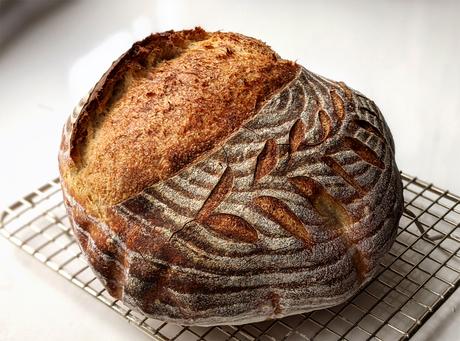
Never would have thought I could obtain these results in my regular oven and without special equipment. But after 11 months of weekly baking, fresh sourdough loaves have become a reliable tradition in our family.
I've been thinking of posting my method for a while, but only now feel confident that it's sufficiently streamlined and repeatable-hence this blog post today!
It all began when my co-worker, Jules, kindly gave me part of her sourdough starter, which came from a restaurateur she knew along with their recipe. Baking bread, though, is very much something that one has to tune to their own equipment, method, and of course liking. Over time, I've been refining my technique to a point where I've been getting consistent results. But by no means is this the only way to bake bread at home and it can certainly be improved.
First, though, you may be wondering - okay, where do I get my own starter? Well, unfortunately, I can't really help you with that. It is possible to grow it from scratch, but it's not easy because it is made of a stable symbiotic mixture of yeast and lactobacilli. My friend Mark Preston describes the process in detail, but as you can read it's a very difficult route which will take a lot of time (and money!) Instead, I recommend asking a baker if they can sell you a piece of their levain starter - or a piece of their uncooked, unsalted sourdough. Speaking of which, there are different kinds of sourdough, each with a different flavor and level of sourness. I like a very mildly sour sourdough, but more sourness (possibly an acquired taste), is appreciated by many (famous is San Francisco's sourdough, which also names its bacterial culture).
So, say you were able to get a hold of some good sourdough starter, what should it look like? The starter is made of living microorganisms that need feeding and produce by-products. The metabolic process is slower at low temperatures and accelerates with heat. If kept in the fridge, after 5-7 days your sourdough starter will be hungry-it will look bubbly, may have liquid on the top (left image below), and it will smell a bit like beer.
If you forget to feed your starter, after a couple of weeks it will start to go bad. It's possible to rescue a starved starter by repeated splitting and feeding, but sometimes it may be too late. If one knows they're not going to be able to feed for ten or more days, it's possible to slow down the starter's metabolism almost completely by freezing it. However, freezing, just like starvation, causes some damage and the thawed starter will need some repeated splitting and feeding to fully come back to life. If at all possible, I recommend treating your starter like a pet and either take it on vacation with you or arrange for someone to care for it during your absence.
FEEDING
Equipment
- Plastic mixing jar.
- High precision kitchen scale.
- Air-tight tub for storing.
Ingredients
- 100 g starter to be fed.
- 100 g high-gluten 'strong' flour.
- 100 g regular tap water, or non-carbonated bottled mineral water if your tap water is especially soft, or very chlorinated. The recipe below assumes water at room temperature.
Instructions
- Use or dispose of all but 100 g of starter.
- Mix 100 g flour and 100 g water and stir energetically.
- Incorporate the 100 g of starter into the mix, stirring from bottom to top.
- Put the mix in an air-tight container and keep in the fridge for 5-8 days undisturbed.
Now that your starter has been fed, you are left with some excess starter which is ripe and ready to be used! The instructions below assume you have about 150 g of ripe starter. If you don't have enough, keep feeding your starter weekly until you have enough feed leftover to bake with.
BAKING BREAD
Equipment
- Proving basket. Using a wooden (rattan) banneton is essential to allow the dough to undergo its final slow rise without drying out while forming a "skin" - the beginning of your bread's crust. I use a 20 cm round basket, similar to this one. If the basket comes with linen lining, the latter can be used to smooth out the basket's walls. Since I like seeing the basket rings in the final product, I use the lining as a lid during proving.
- Cast iron casserole, a.k.a. Dutch oven. A 4.7 liters one will work perfectly for the recipe I'm about to describe. Baking in a casserole is very important since an enclosed space is essential when using a standard oven because it fills with steam during baking, allowing the bread to cook through without burning while rising. A double-dutch oven (with the shallow half placed at the bottom) or a spun-iron baking cloche can also be used and are preferable to the casserole, as I'll explain later.
- Scoring blade (optional), similar to this one. A very sharp paring knife can also be used.
- Cooling rack (optional). Two wooden spoons placed flat on a cutting board can also be used to support the loaf while it cools down.
Ingredients
NOTE: These quantities make a ~800 g loaf (about 20 cm in diameter, 12 cm tall) which fits in a 4.7 l casserole.- 150 g ripe sourdough starter.
- 150 g strong flour and 150 g of water for the first rise.
- 330 g strong flour and 150 g of water for the second rise.
- 1 tablespoon rice or semolina flour as a coating for the proving basket.
Instructions
NOTE: I'm presenting the slow-rise version of this recipe. It can be shortened by reducing or removing the resting time in the fridge, replacing it with a shorter resting time outside of the fridge (8 hours in the fridge equal to about 1 hour outside of it). However, I should warn you that for reasons beyond my understanding, slow-risen bread will look and taste better! Day 1- Mix 150 g flour + 150 g water then incorporate 150 g starter and leave out of fridge 4-6 hrs (4 hrs on a hot summer day, 6 hrs in winter). After this time, the mix should look quite bubbly and have roughly doubled in size. Put it in the fridge overnight in an airtight container.
- In a large mixing bowl, combine 330 g strong flour and 10 g table salt. Then add 150 g water and the risen mix from Day 1. Mix as best as you can in the mixing bowl by using a big spoon (can use a food processor as well for this step.) Let it rest at room temperature for half an hour.
- Place the dough on a floured wooden surface and knead every half hour for 2 additional hours. I tried using a food processor, but I've achieved the best results by folding by hand until the dough becomes stiff and hard to work further. I don't have a good explanation for this difference, but I suspect that manual folding is gentler on the gluten strands which can break if overstretched. Also, manual-folding may incorporate some air between the folds.
- During the last fold, keep track of where the seam is as you will want it to become your bottom crust, with the opposite side being the top.
- Brush proving basket generously and thoroughly with semolina or rice flour. These are preferable to regular wheat flour as the latter tends to become moist and stick to the basket during proving (a quite unfortunate event!)
- Put the dough in the basket upside down (seam up), leave in the fridge for 8 hrs or overnight to prove covered with a towel or linen lid. After this time the dough should have increased in volume by about 50%.
- With the proofing basket still in the fridge, preheat the oven with the cast-iron casserole inside for about 30 mins at 250℃ (480℉).
- Take the proving basket out of the fridge, flip it on a sheet of grease-free parchment paper.
- Score the top with a sharp knife or razor blade. These cuts will expand during cooking allowing excess CO2 to escape and the crust to expand for the final in-oven rise. I like to make one big cut, at least 5 mm (1/4") deep, and shallower cuts as a decoration. Bread scoring is a difficult and fascinating art, I only lately have started to obtain decent results - don't be upset if your bread breaks in all the wrong places!
- Lifting by the parchment paper, place the dough into the super-hot casserole. This operation is easier if using a baking cloche or a double Dutch oven.
- Immediately, put the lid on, put the casserole back in the oven, and bake 40 minutes at 250℃ (480℉).
- Remove the lid and bake 10 more minutes lowering the temperature to 230℃ (450℉) if you have a fan oven, or maintaining 250℃ (480℉) otherwise.
- After baking, lift by the parchment paper and place the loaf on the wire rack to let it cool for at least half an hour before cutting into it. If the rise was sufficiently uniform, the scoring cuts will have uniformly expanded.
- Allow the proving basket to dry in warm air (I leave mine near the oven as the bread bakes), then brush off the excess flour using a dedicated hard brush. If some of the dough stuck to it, the basket can be washed in cold water without any detergents and then allowed to air-dry.
If things went well, your loaf should be fragrant, slightly chewy, and should have air bubbles of varying size trapped into it.
Using a flour which is not very strong or mixing in whole-wheat flours will produce smaller, more uniform bubbles and a mealier texture. Small bubbles and a tougher, denser loaf may also be the result of an under proved or over proved fermentation, or the effect of machine kneading.
Preserving baked bread
If the loaf is left whole, the crust will provide a natural barrier that will keep the bread fresh for a day. A slightly stale loaf will regain its fragrance if warmed up in the oven, or in a toaster if sliced. If the bread is not going to be consumed within the day, I recommend freezing it in halves or quarters as soon as it has cooled down. Allow the frozen loaf to thaw at room temperature for one hour, or for 5 minutes in the microwave set to the lowest power setting.
Variations
The recipe I described is very much like a blank canvas! Different kinds of flours can be mixed in (e.g. whole wheat, spelt, sprouted grains), as well as other ingredients added (olives, nuts, dried figs, shredded cheese.) A tablespoon of olive oil will result in a softer loaf that will stay fresh for longer.
What about sourdough pizza, pretzel, donuts? Yes, please! All of those and more are possible and delicious. I've been experimenting with some of these variations, but my results are still inconsistent. I'll report back when I'll know more-please send me your recipes!


